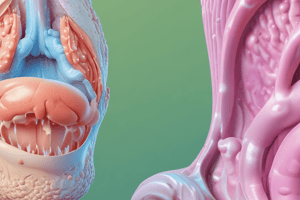Podcast
Questions and Answers
Sacral neuromodulation may be considered for patients with recalcitrant urinary urge incontinence who have failed other conservative measures, including bladder training, pelvic floor physical therapy with biofeedback, and pharmacologic treatment. Practice Bulletin No. 155 Is there a role for estrogen in the treatment of urinary incontinence? Systemic estrogen therapy, with or without progesterone, does not appear to be effective in the prevention or treatment of urinary incontinence; in fact, several large trials of hormone therapy have found an increased occurrence of stress incontinence in users of hormone therapy (estrogen alone or combined with progesterone) (59, 60). Locally administered (vaginal) estrogen, however, may be of some benefit in decreasing ______.
Sacral neuromodulation may be considered for patients with recalcitrant urinary urge incontinence who have failed other conservative measures, including bladder training, pelvic floor physical therapy with biofeedback, and pharmacologic treatment. Practice Bulletin No. 155 Is there a role for estrogen in the treatment of urinary incontinence? Systemic estrogen therapy, with or without progesterone, does not appear to be effective in the prevention or treatment of urinary incontinence; in fact, several large trials of hormone therapy have found an increased occurrence of stress incontinence in users of hormone therapy (estrogen alone or combined with progesterone) (59, 60). Locally administered (vaginal) estrogen, however, may be of some benefit in decreasing ______.
urinary incontinence
Is there a role for bulking agents in the treatment of ______? A number of bulking agents have been used for the treatment of stress incontinence with intrinsic sphincter deficiency in women. The bulking agents are injected transurethrally or periurethrally into the periurethral tissue around the bladder neck and proximal urethra to increase urethral resistance.
Is there a role for bulking agents in the treatment of ______? A number of bulking agents have been used for the treatment of stress incontinence with intrinsic sphincter deficiency in women. The bulking agents are injected transurethrally or periurethrally into the periurethral tissue around the bladder neck and proximal urethra to increase urethral resistance.
urinary incontinence
Thus, sacral neuromodulation may be considered for patients with recalcitrant ______ incontinence who have failed other conservative measures, including bladder training, pelvic floor physical therapy with biofeedback, and pharmacologic treatment. Practice Bulletin No. 155 Is there a role for estrogen in the treatment of urinary incontinence? Systemic estrogen therapy, with or without progesterone, does not appear to be effective in the prevention or treatment of urinary incontinence; in fact, several large trials of hormone therapy have found an increased occurrence of stress incontinence in users of hormone therapy (estrogen alone or combined with progesterone) (59, 60). Locally administered (vaginal) estrogen, however, may be of some benefit in decreasing urinary incontinence.
Thus, sacral neuromodulation may be considered for patients with recalcitrant ______ incontinence who have failed other conservative measures, including bladder training, pelvic floor physical therapy with biofeedback, and pharmacologic treatment. Practice Bulletin No. 155 Is there a role for estrogen in the treatment of urinary incontinence? Systemic estrogen therapy, with or without progesterone, does not appear to be effective in the prevention or treatment of urinary incontinence; in fact, several large trials of hormone therapy have found an increased occurrence of stress incontinence in users of hormone therapy (estrogen alone or combined with progesterone) (59, 60). Locally administered (vaginal) estrogen, however, may be of some benefit in decreasing urinary incontinence.
urinary urge
Is there a role for ______ in the treatment of urinary incontinence? A number of bulking agents have been used for the treatment of stress incontinence with intrinsic sphincter deficiency in women. The bulking agents are injected transurethrally or periurethrally into the periurethral tissue around the bladder neck and proximal urethra to increase urethral resistance.
Is there a role for ______ in the treatment of urinary incontinence? A number of bulking agents have been used for the treatment of stress incontinence with intrinsic sphincter deficiency in women. The bulking agents are injected transurethrally or periurethrally into the periurethral tissue around the bladder neck and proximal urethra to increase urethral resistance.
Signup and view all the answers
Thus, sacral neuromodulation may be considered for patients with recalcitrant urinary urge incontinence who have failed other conservative measures, including bladder training, pelvic floor physical therapy with ______, and pharmacologic treatment. Practice Bulletin No. 155 Is there a role for estrogen in the treatment of urinary incontinence? Systemic estrogen therapy, with or without progesterone, does not appear to be effective in the prevention or treatment of urinary incontinence; in fact, several large trials of hormone therapy have found an increased occurrence of stress incontinence in users of hormone therapy (estrogen alone or combined with progesterone) (59, 60). Locally administered (vaginal) estrogen, however, may be of some benefit in decreasing urinary incontinence.
Thus, sacral neuromodulation may be considered for patients with recalcitrant urinary urge incontinence who have failed other conservative measures, including bladder training, pelvic floor physical therapy with ______, and pharmacologic treatment. Practice Bulletin No. 155 Is there a role for estrogen in the treatment of urinary incontinence? Systemic estrogen therapy, with or without progesterone, does not appear to be effective in the prevention or treatment of urinary incontinence; in fact, several large trials of hormone therapy have found an increased occurrence of stress incontinence in users of hormone therapy (estrogen alone or combined with progesterone) (59, 60). Locally administered (vaginal) estrogen, however, may be of some benefit in decreasing urinary incontinence.
Signup and view all the answers
Is there a role for bulking agents in the treatment of urinary incontinence? A number of ______ have been used for the treatment of stress incontinence with intrinsic sphincter deficiency in women. The bulking agents are injected transurethrally or periurethrally into the periurethral tissue around the bladder neck and proximal urethra to increase urethral resistance.
Is there a role for bulking agents in the treatment of urinary incontinence? A number of ______ have been used for the treatment of stress incontinence with intrinsic sphincter deficiency in women. The bulking agents are injected transurethrally or periurethrally into the periurethral tissue around the bladder neck and proximal urethra to increase urethral resistance.
Signup and view all the answers
Thus, sacral neuromodulation may be considered for patients with recalcitrant urinary urge incontinence who have failed other conservative measures, including bladder training, pelvic floor physical therapy with biofeedback, and ______ treatment. Practice Bulletin No. 155 Is there a role for estrogen in the treatment of urinary incontinence? Systemic estrogen therapy, with or without progesterone, does not appear to be effective in the prevention or treatment of urinary incontinence; in fact, several large trials of hormone therapy have found an increased occurrence of stress incontinence in users of hormone therapy (estrogen alone or combined with progesterone) (59, 60). Locally administered (vaginal) estrogen, however, may be of some benefit in decreasing urinary incontinence.
Thus, sacral neuromodulation may be considered for patients with recalcitrant urinary urge incontinence who have failed other conservative measures, including bladder training, pelvic floor physical therapy with biofeedback, and ______ treatment. Practice Bulletin No. 155 Is there a role for estrogen in the treatment of urinary incontinence? Systemic estrogen therapy, with or without progesterone, does not appear to be effective in the prevention or treatment of urinary incontinence; in fact, several large trials of hormone therapy have found an increased occurrence of stress incontinence in users of hormone therapy (estrogen alone or combined with progesterone) (59, 60). Locally administered (vaginal) estrogen, however, may be of some benefit in decreasing urinary incontinence.
Signup and view all the answers
Is there a role for ______ in the treatment of urinary incontinence? A number of bulking agents have been used for the treatment of stress incontinence with intrinsic sphincter deficiency in women. The bulking agents are injected transurethrally or periurethrally into the periurethral tissue around the bladder neck and proximal urethra to increase urethral resistance.
Is there a role for ______ in the treatment of urinary incontinence? A number of bulking agents have been used for the treatment of stress incontinence with intrinsic sphincter deficiency in women. The bulking agents are injected transurethrally or periurethrally into the periurethral tissue around the bladder neck and proximal urethra to increase urethral resistance.
Signup and view all the answers
Thus, sacral neuromodulation may be considered for patients with recalcitrant urinary urge incontinence who have failed other conservative measures, including bladder training, pelvic floor physical therapy with biofeedback, and ______ treatment. Practice Bulletin No. 155 Is there a role for estrogen in the treatment of urinary incontinence? Systemic estrogen therapy, with or without progesterone, does not appear to be effective in the prevention or treatment of urinary incontinence; in fact, several large trials of hormone therapy have found an increased occurrence of stress incontinence in users of hormone therapy (estrogen alone or combined with progesterone) (59, 60). Locally administered (vaginal) estrogen, however, may be of some benefit in decreasing urinary incontinence.
Thus, sacral neuromodulation may be considered for patients with recalcitrant urinary urge incontinence who have failed other conservative measures, including bladder training, pelvic floor physical therapy with biofeedback, and ______ treatment. Practice Bulletin No. 155 Is there a role for estrogen in the treatment of urinary incontinence? Systemic estrogen therapy, with or without progesterone, does not appear to be effective in the prevention or treatment of urinary incontinence; in fact, several large trials of hormone therapy have found an increased occurrence of stress incontinence in users of hormone therapy (estrogen alone or combined with progesterone) (59, 60). Locally administered (vaginal) estrogen, however, may be of some benefit in decreasing urinary incontinence.
Signup and view all the answers
Is there a role for ______ in the treatment of urinary incontinence? A number of bulking agents have been used for the treatment of stress incontinence with intrinsic sphincter deficiency in women. The bulking agents are injected transurethrally or periurethrally into the periurethral tissue around the bladder neck and proximal urethra to increase urethral resistance.
Is there a role for ______ in the treatment of urinary incontinence? A number of bulking agents have been used for the treatment of stress incontinence with intrinsic sphincter deficiency in women. The bulking agents are injected transurethrally or periurethrally into the periurethral tissue around the bladder neck and proximal urethra to increase urethral resistance.
Signup and view all the answers





